Homemade Caesar salad dressing is easy to make and so flavorful. Made in only 15 minutes, this is the best Caesar dressing recipe there is, and will spoil you for any other Caesar dressing!
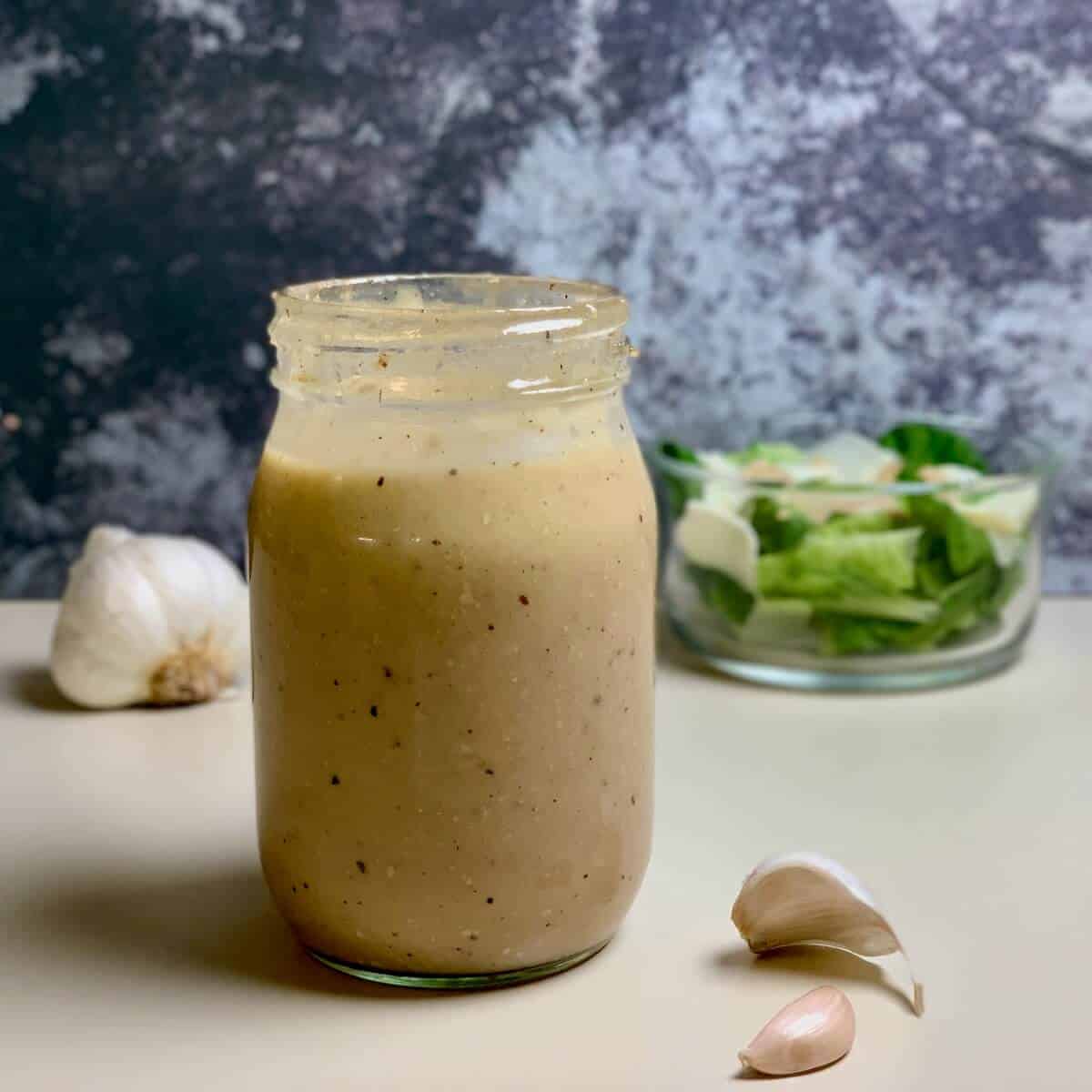
Jump to:
[June, 2021: I've reworked the recipe and updated this post with all new pictures. Enjoy!]
Why this recipe works
- You control how garlicky or lemony the finished Caesar dressing is
- Using fresh ingredients gives the dressing bright flavor
- You can make it in a food processor or by hand
Let’s talk about getting dressed…er…I mean dressing your salad. Salad dressing is one of those easy-to-make-but I-don’t-know-how/want-to products.
From simple herb vinaigrettes recipes to a (slightly) more energetic Caesar salad dressing recipe, knowing a couple of simple tricks can lead to a wide variety of flavors with which to enhance your greens.
I’ve discussed the recipe ratios for scones, pound cakes, and pie crusts, so you may not be surprised to know that there’s an easy recipe ratio for vinaigrettes (aka oil and vinegar dressings), 1 : 3, that is, 1 part vinegar to 3-parts oil, by weight. The rest is just seasonings.
For a Caesar salad dressing recipe, there's a little bit of science you need to know to be successful.
Recipe Ingredients
You'll need the following ingredients to make this Caesar dressing recipe:
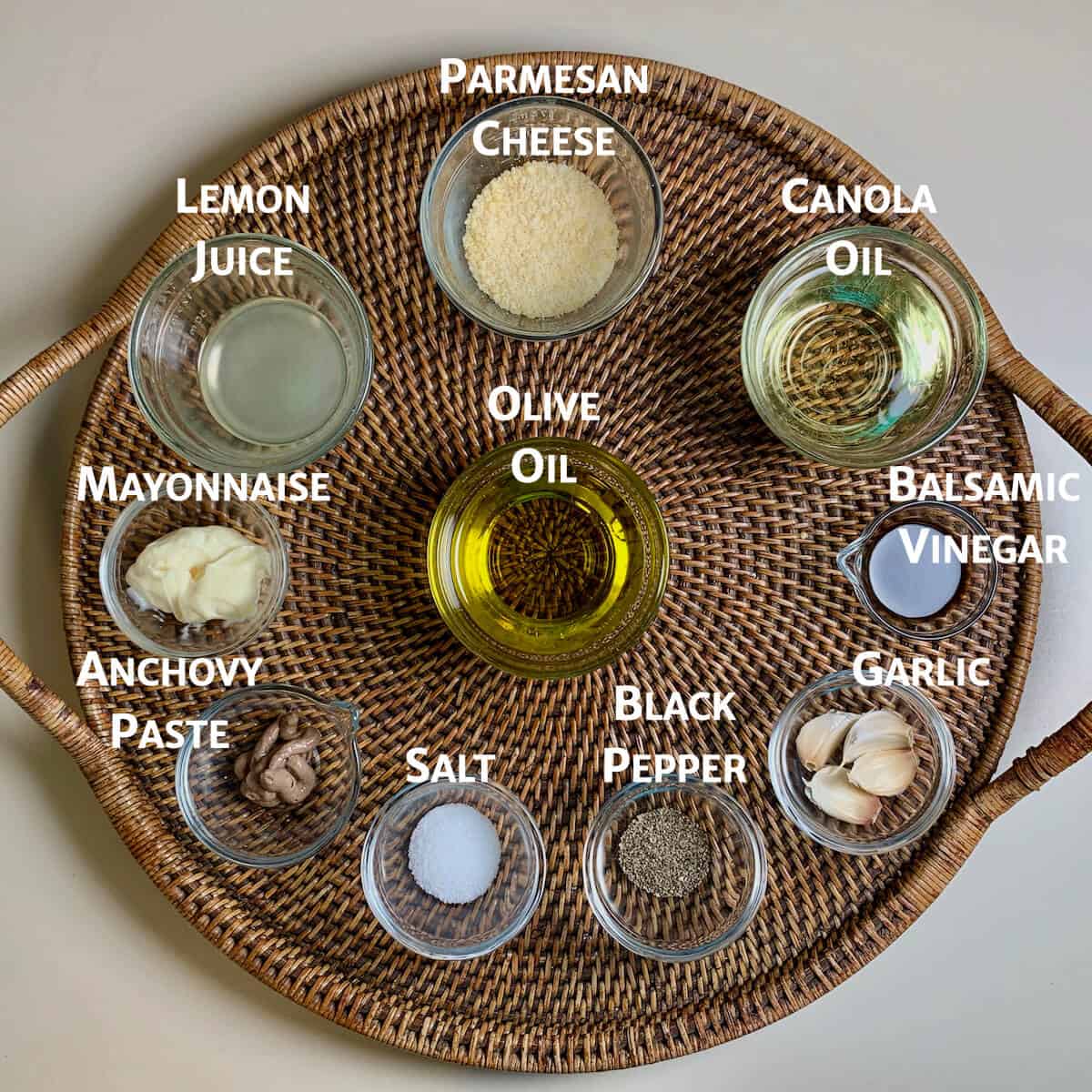
Ingredient Notes
Garlic: The main flavoring ingredient for Caesar dressing. To avoid any bitterness, peel out the green center of the clove before chopping it up.
Mayonnaise: Most classic Caesar dressings are made with a raw egg yolk to help with the emulsion. Since good quality mayonnaise is made from egg yolks (and is usually pasteurized), you can safely use it as a substitute, and there's no worry about serving raw eggs.
Anchovy paste: Used for that umami flavoring. You have the option of using whole anchovies and making a paste with them yourself (especially if you're going to make the dressing by hand). If you don't have (or don't like) anchovy paste, you can substitute ½ teaspoon Worcestershire sauce (or to taste), or just leave it out altogether.
Oils: I use a combination of olive oil and canola oil in this Caesar salad dressing recipe. I find the canola oil makes the salad dressing a little lighter in texture, allowing the emulsion to hold better.
See the recipe card for a full list of ingredients and measurements.
How to make Caesar salad dressing
Step 1: Make the base
Chop the garlic with salt until the garlic is finely minced (photo 1).
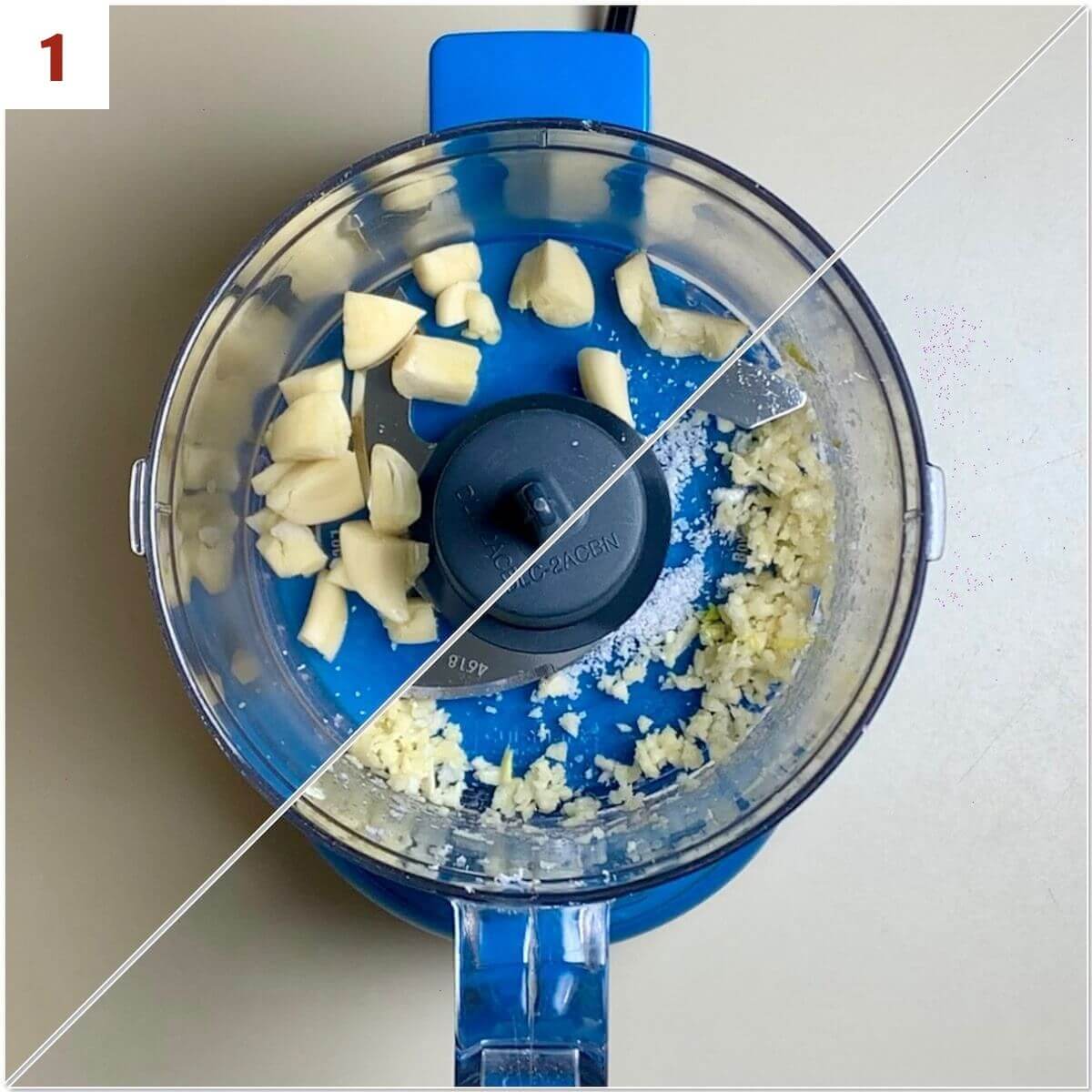
Add the lemon juice, mayonnaise, anchovy paste, and balsamic vinegar, and pulse to combine (photo 2).
You can adjust the balance of lemon juice and garlic at this point, but remember that the oils will mute the sharpness a bit.
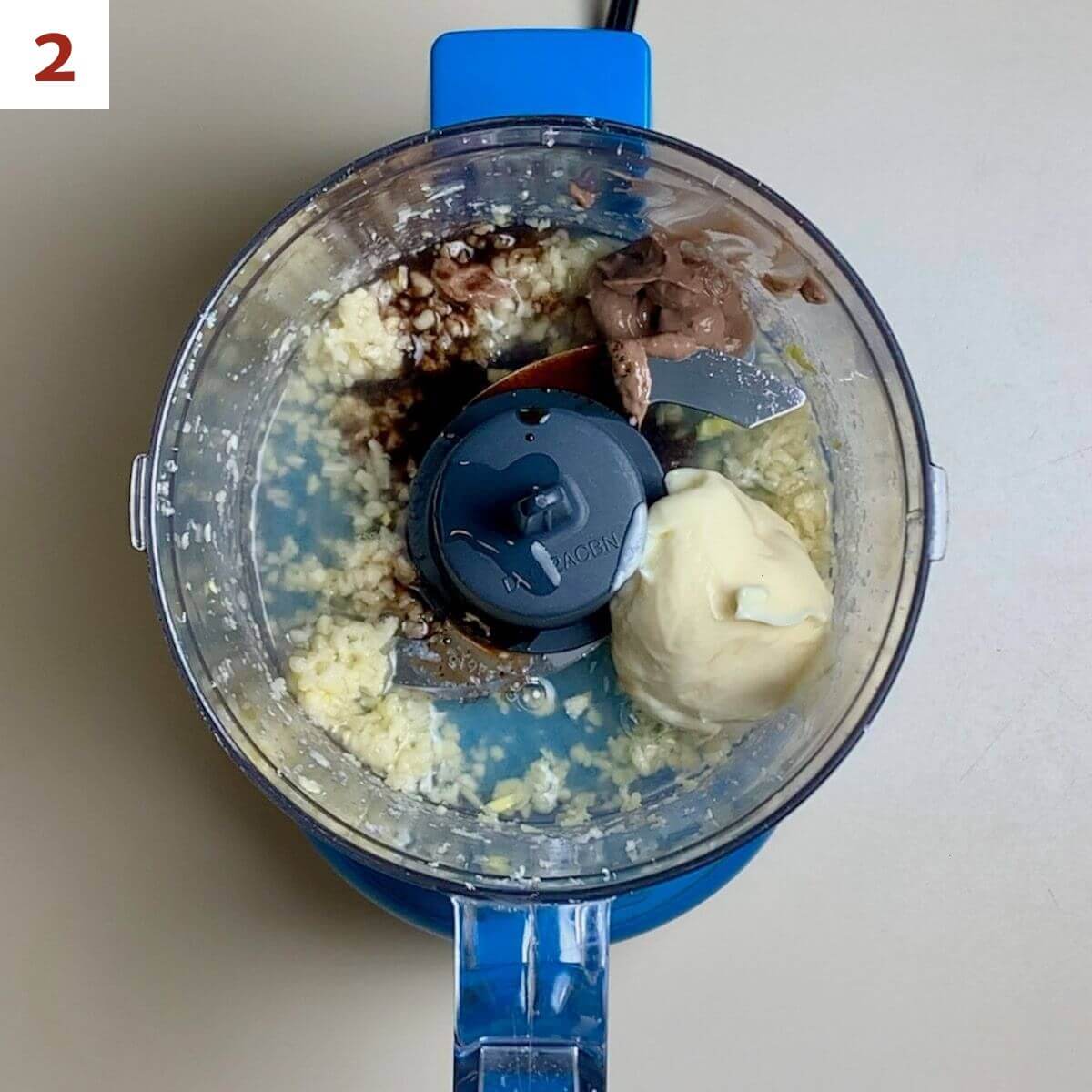
Step 2: Create the emulsion
Create the emulsion starting with the olive oil. Begin adding the oil through the lid at a slow stream a little at a time, pulsing the processor on/off to avoid heating and breaking the emulsion (photo 3).
Similarly stream the canola oil after all the olive oil has been added.

Step 3: Add the flavorings
Add the parmesan cheese and black pepper, and pulse just to mix them in (photo 4).
Here's another chance to adjust the seasonings as desired.

Storage Instructions
Transfer the dressing to a glass jar with a tight-fitting lid (photo 5). Homemade Caesar dressing can be stored in the refrigerator for up to 1 week.
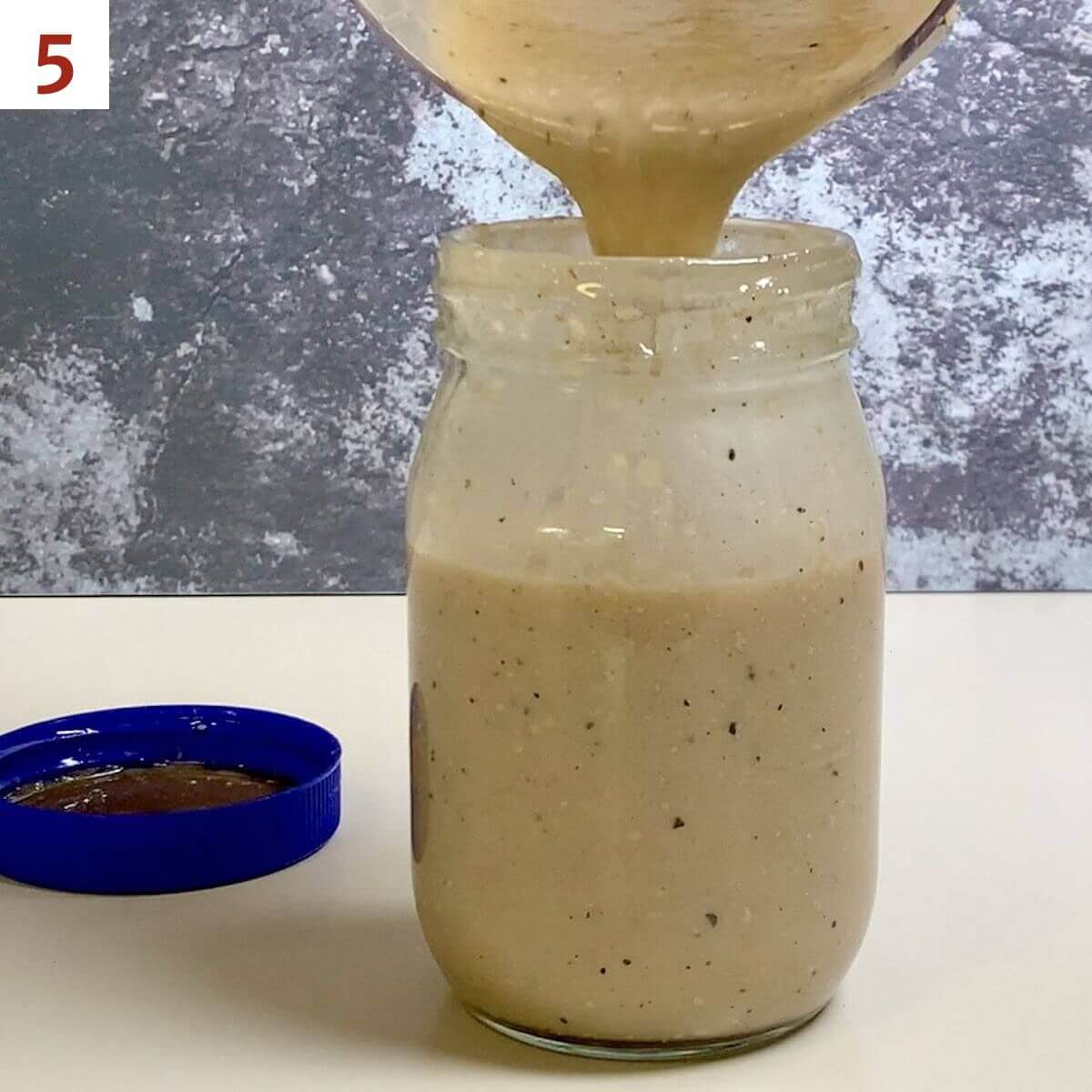
Questions asked and answered
Here are some questions you might have...
Here’s your word-of-the-week: emulsion, meaning a mixture that doesn’t separate.
We all know that oil and water don’t stay mixed, and you have to shake a vinaigrette to temporarily combine them. For a more permanent solution for recipes for classic Caesar salad dressing, mayonnaise, or aioli (like this dipping sauce for sweet potato fries), keeping oil and vinegar mixed needs some help.
Look at that salad dressing bottle in your refrigerator. Chances are there is some chemical ingredient listed as an emulsifier, i.e. something that keeps the oil and water in suspension.
Lethicin, a substance found in egg yolks, acts as an emulsifier by attaching a water molecule to one end and a fat molecule to the other, thereby keeping them from separating. That’s why you’ll see it on a Caesar dressing label.
Homemade Caesar salad dressing is made by combining the “wet” ingredients, then slowly drizzling in the oil so the lethicin in the yolks has a chance to grab those fat molecules and keep them in suspension with the water molecules.
If you add the oils too fast, the dressing will “break” (the emulsion separates), and you’ll have a tasty, but messier, dressing. If your dressing breaks, you can fix it using this method from Serious Eats.
Sure! Just substitute a vegan mayonnaise and replace the anchovies with ½ teaspoon Worcestershire sauce and 1 tablespoon of capers. You can leave out the parmesan cheese or use a vegan replacement. Season to taste.
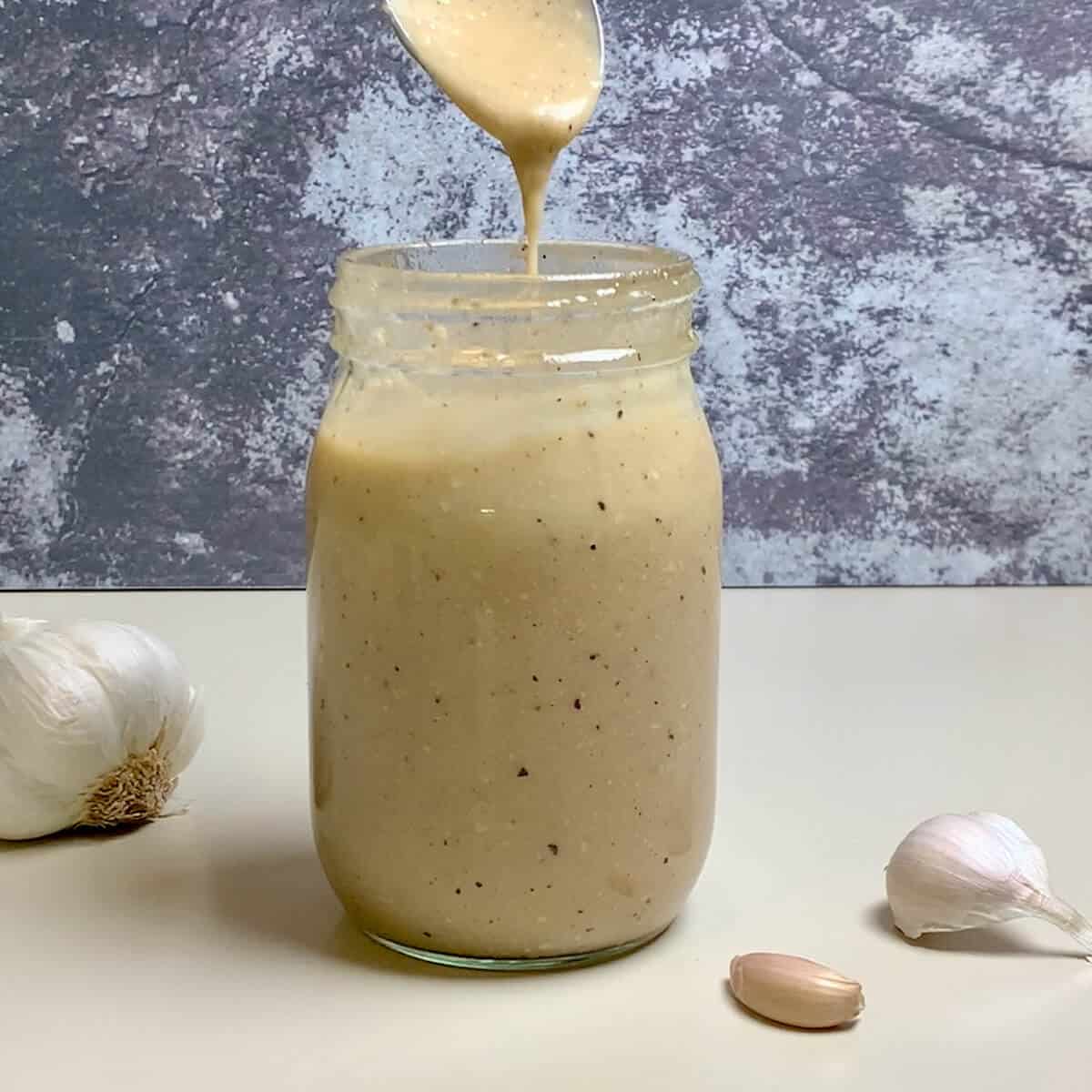
Secrets to Caesar dressing success
Over time I’ve discovered some tips for making my homemade Caesar salad dressing:
- Use a combination of olive and canola oil to lighten up the mixture (in texture, not calories)
- Add the olive oil first because, as a heavier oil than canola, the emulsion holds together better
- When adding in the oils, pulse the food processor rather than just let it run so the dressing doesn’t heat up and break
Helpful tools for making Caesar dressing
You can make a Caesar dressing recipe two ways, by hand or using a food processor.
I use my Cuisinart Mini Prep Plus food processor because (1) I don’t have to mince garlic, and (2) the holes in the lid help to slow the addition of the oil. That really helps create a stable emulsion.
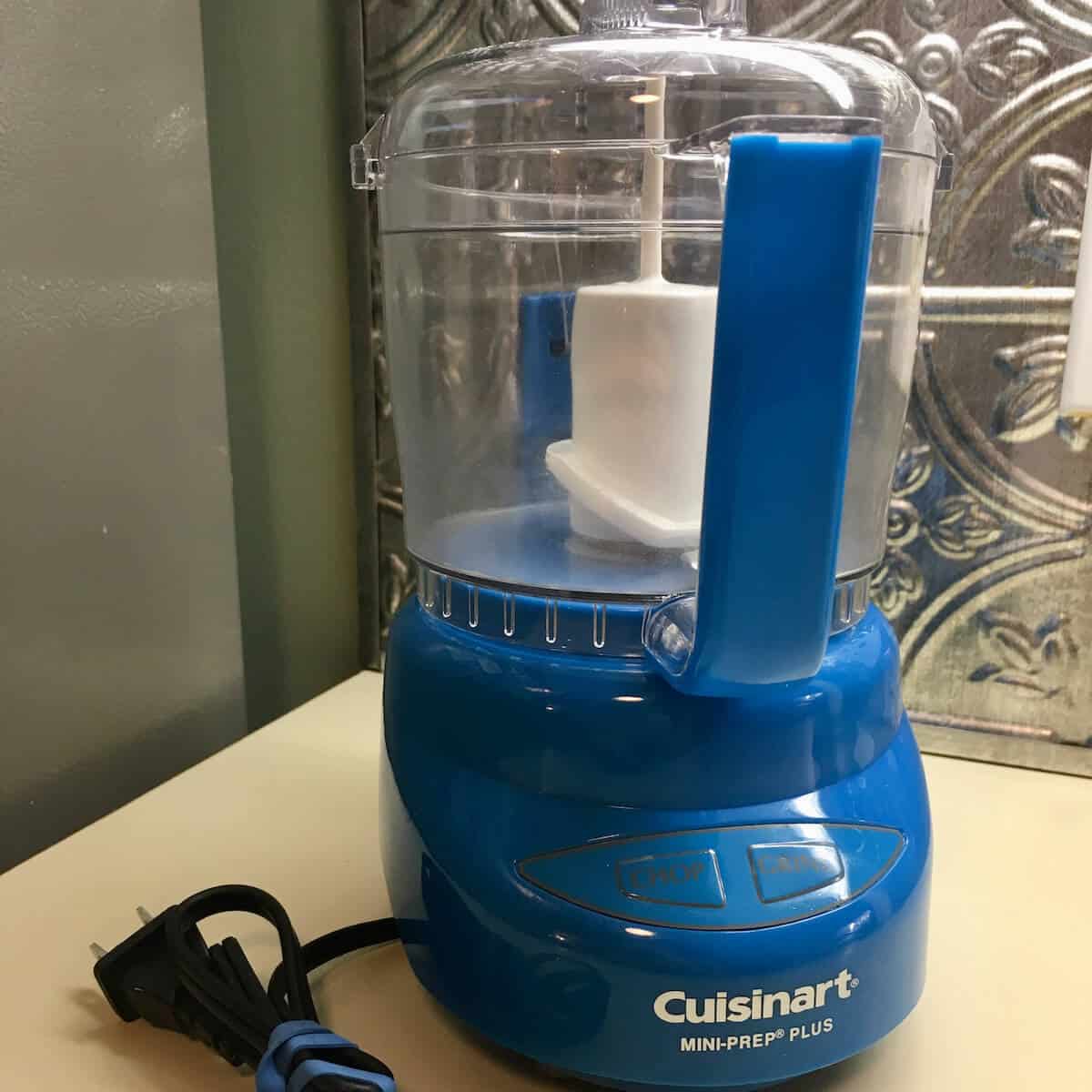
Another tool I use is this really cool KitchenAid citrus squeezer when I need to juice a lemon. It strains out the seeds so all you pour out is juice. You know, so you're not chasing seeds around the bowl trying to fish them out! I use it quite frequently, like when making lemon curd or Mint Lemon Lime Bars.
The process for making a homemade Caesar salad dressing recipe is quick and easy with the right tools. However, I'll give you instructions to make the dressing by hand in the recipe card below, don't worry!
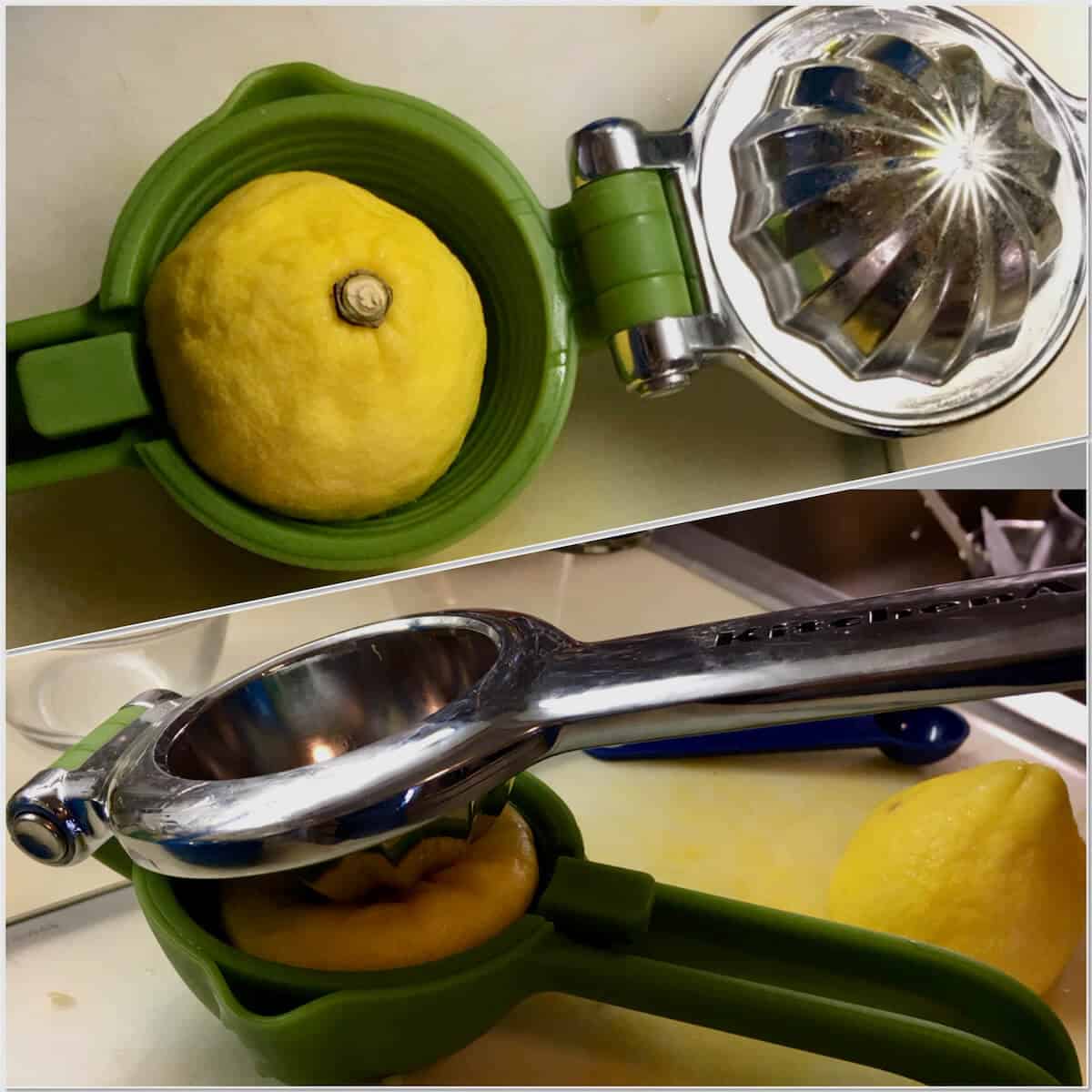
Bright flavor abounds
The balance of lemon juice and balsamic vinegar really brightens the flavor of this Caesar dressing, while the garlic, parmesan, and anchovy paste pack a flavor punch. The mouthfeel is creamy but not heavy from using both the olive and canola oils.
This truly is the best Caesar salad dressing you'll ever have!
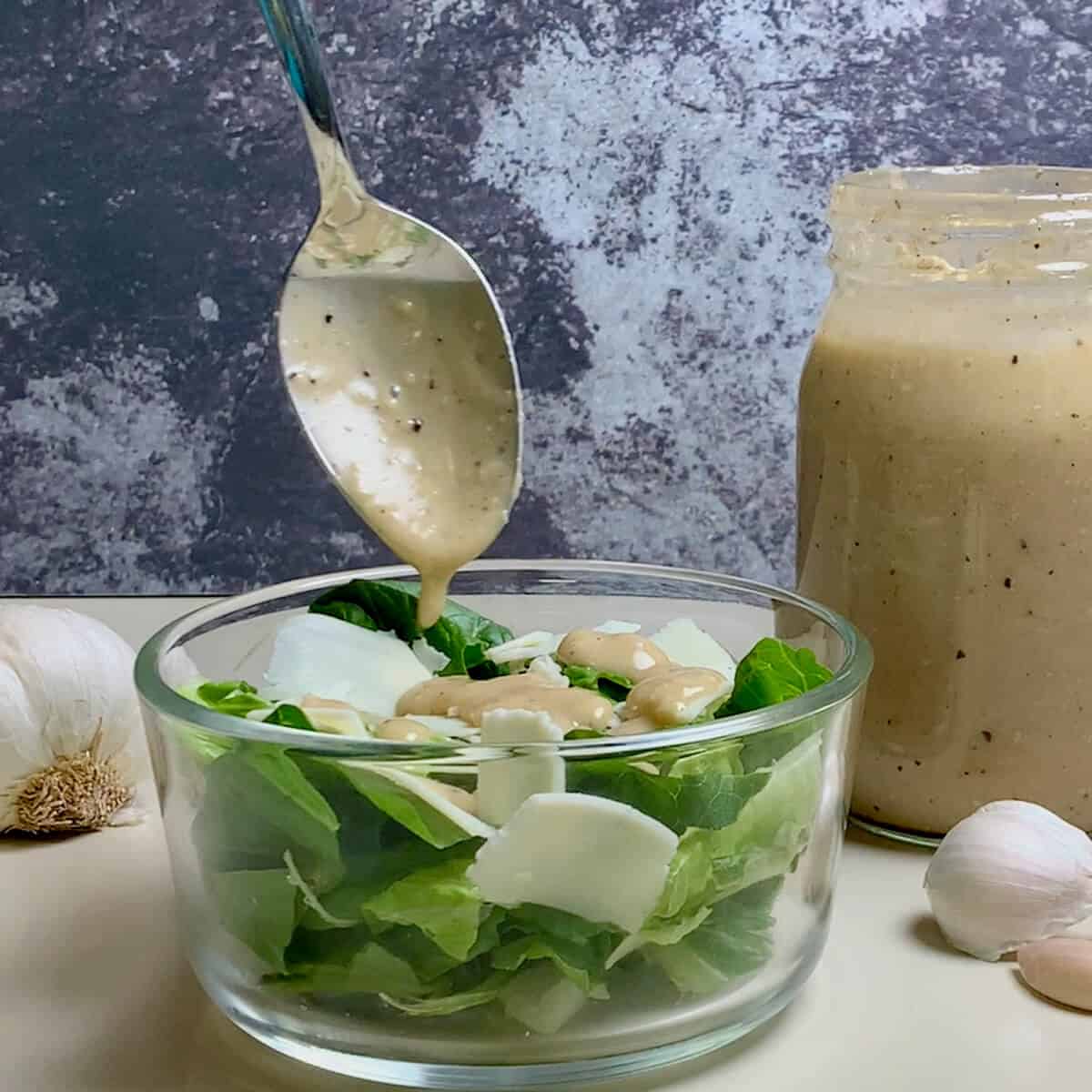
My older daughter tells me that I’ve spoiled her for Caesar salad in restaurants or from a jar, that’s how good this homemade Caesar salad dressing is!
So don’t reach for a bottled salad dressing. Invest in some good quality vinegars and oils, and let your imagination run free. You’ll be able to pronounce everything that goes into what dresses your salad, and your taste buds will definitely thank you!
Slainté! L’chaim! Cheers!
Tammy
Try these recipes next
Did you know that salad dressing is a form of an emulsion sauce, that is, a mixture of oil and water? There are temporary emulsions that don't stay mixed (like vinaigrettes) and stable emulsions that stay mixed over time (like Caesar dressing or Hollandaise Sauce). These can add a layer of flavor to your dishes. Here are a few ideas to get you started:
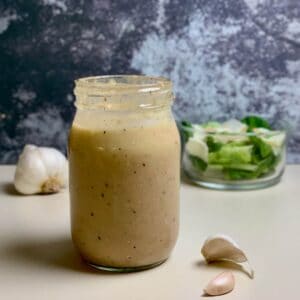
Homemade Caesar Salad Dressing
Equipment
Ingredients
- 4 garlic cloves, roughly chopped, see Recipe Notes
- 1 teaspoon kosher salt
- 3 tablespoons lemon juice, freshly squeezed from 1 lemon, or more to taste,
- 2 tablespoons mayonnaise, see Recipe Notes
- 1 teaspoon anchovy paste, or 4 anchovy fillets, minced, see Recipe Notes
- 1 teaspoon balsamic vinegar
- ½ cup extra virgin olive oil
- ½ cup canola oil
- ¼ cup parmesan cheese, freshly grated
- ¼ to ½ teaspoon black pepper, freshly ground
Instructions
- Using a food processor: Place garlic cloves and salt in a small food processor. Pulse until the garlic is minced.
- Add the lemon juice, mayonnaise, anchovy paste (or anchovy fillets, if using), and balsamic vinegar, and pulse to combine. Taste for salt, garlic, and lemon juice balance.
- Starting with the olive oil, begin adding the oil through the lid at a slow stream, pulsing the processor on/off to avoid heating and breaking the emulsion. Similarly stream the canola oil after all the olive oil has been added.
- Add Parmesan cheese and black pepper, then pulse just to combine. Adjust the seasonings if needed.
- Make by hand: Place garlic and salt (and anchovy fillets, if using) on a cutting board. Using the flat side of a chef’s knife, carefully smash ingredients together until mixture becomes a thick paste and is thoroughly blended. Transfer paste to a small bowl.
- Add lemon juice, mayonnaise, anchovy paste (if using), and balsamic vinegar to the paste, and whisk until blended.
- Slowly stream in the oils (first olive oil, then canola oil) in a slow, steady stream, whisking constantly until smooth.
- Whisk in parmesan cheese, and season with black pepper to taste.
- Storage instructions: Transfer the dressing to a glass jar with a tight-fitting lid. Caesar dressing can be stored in the refrigerator for up to 1 week.

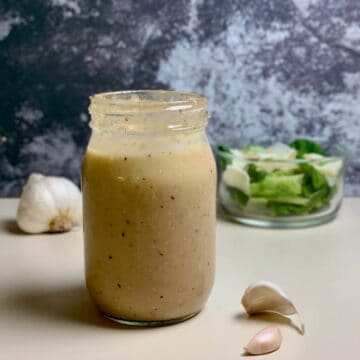
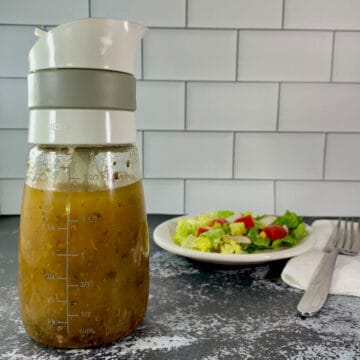
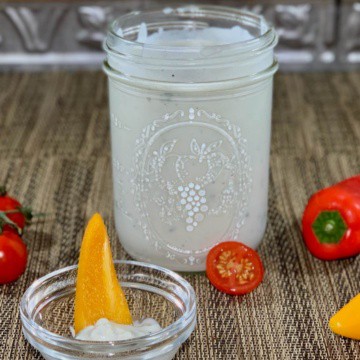
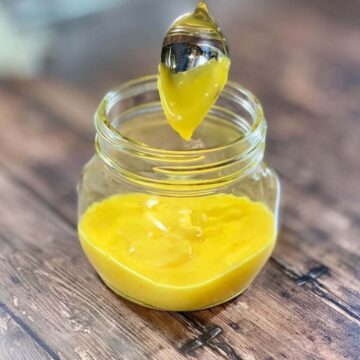


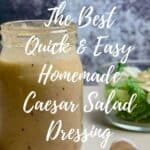
shirasp says
It really is is the best dressing ever. YUMMY
Sandy S. says
So thankful you posted this! I was just thinking that I needed to find a caesar dressing I could make at home easily - you must have read my mind! Wishing you all a beautiful simcha!